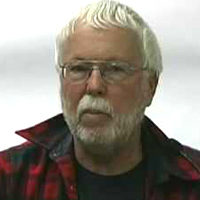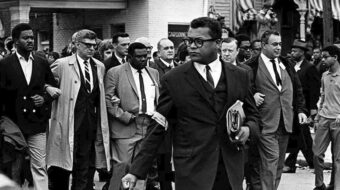
The American working class suffered a great loss on Jan. 31 with the passing of Anita Torrez. Torrez, who celebrated her 94th birthday last fall, spent almost her entire adult life in the struggles for economic justice and against racist and sexist discrimination.
Born and raised by farmworkers in the small farming village of Gila, in Southwestern New Mexico, she encountered racism at an early age. At the time she entered first grade, Chicano and Mexican children were punished for speaking Spanish—even outside the classroom. She knew at that tender age that it was an unjust policy, but did not yet know how to fight back. In high school, she fell for classmate Lorenzo Torrez, beginning a lifelong and loving relationship that lasted until Lorenzo’s death in 2012.
Lorenzo dropped out of school for a tour in the U.S. Army towards the end of World War II. They were married after his discharge in 1948 and began raising a family. No one would have foreseen back then that these two young farm kids would become great working-class leaders.
Lorenzo found a job in the smelter at the Empire Zinc Mine in the camp of Hanover, N.M., where the workers lived in company housing. As was the case in most Southwestern mines, the Chicano miners were paid less, had rougher jobs, and lived in inferior housing without running water.
In 1950, the miners at Empire went on strike. They were represented by the International Union of Mine, Mill, and Smelter Workers, often referred to as Mine Mill, a left CIO union with a militant fighting history, especially among the Chicano workers of the Southwest.
Although not a large mine, the strike at Empire became a test for the union, with miners and bosses in the region’s Mining Belt waiting to see the outcome, expecting it to set the standard for contracts at other area mines. After months of picketing, the company—which owned all the elected officials and judges in the county—got an injunction against picketing by the union.
After much hair-pulling and debate, the mining families decided to turn the picket duties over to the women, who were not union members and therefore not covered by the injunction. Mines would not hire women until the 1970s. When word got out about the women’s picket line, they were joined by women from other mining towns. Anita was already involved in strike support, but now she was on the picket line. In spite of police harassment and company goons, the women held strong, and eventually, the bosses were forced to capitulate.
This long struggle was immortalized in the film Salt of the Earth, the only U.S. film ever blacklisted. Unavailable for decades, it is now listed by the Library of Congress as one of the country’s 100 best films of all time. To this day, few Americans have seen the film, though it was distributed widely across the world, especially in socialist countries. It’s said that Salt of the Earth has been seen by more people than any other film in world history.
A Hollywood crew filmed the movie on location in New Mexico and used local people for most of the roles. Both Anita and Lorenzo played parts in the film, with Lorenzo having a speaking role. Years later he would often introduce Anita as “my favorite movie star.” Like most mining camps in the Southwest, the union at Empire included Communists, who contributed some of the most advanced leadership during the strike. By the time the strike and film were over, both Lorenzo and Anita had joined the Communist Party, where they remained active the rest of their lives.
After the war, Anita worked for Planned Parenthood in rural New Mexico. Even later in life, she often talked about the difficulty faced in convincing people to use contraceptives, especially the men. She said that women were often afraid to tell their husbands they were relying on birth control, and when the wives became pregnant less often, their husbands worried something was wrong with their virility. She explained that it was rewarding work, even when it was a struggle against the influences of tradition and church dogma.
Meanwhile, the Red Scare of the 1950s resulted in the persecution of Communists and class-struggle unionists. Lorenzo would get a job in this or that mining town, but within a few weeks, the FBI would show up and get the boss to fire him. By the 1960s, Anita and Lorenzo were in Los Angeles, where Lorenzo helped in efforts to build the Communist Party among Chicano workers.
They moved to Tucson in 1975 when Lorenzo assumed leadership of the Arizona/New Mexico District of the CPUSA. Lorenzo also chaired the party’s national Chicano/Mexicano Equality Commission. Anita got a job in a sewing factory, which she soon helped organize with the International Ladies Garment Workers Union. She played a leadership role in that factory union until she retired.

She actively distributed the People’s World newspaper for decades and gathered signatures when Lorenzo ran for political office and for CP candidates Gus Hall and Angela Davis when they ran for president and vice president. During this time, she and Lorenzo raised their three children and later helped with grandchildren.
In 1992, Anita and Lorenzo were among the founders of Salt of the Earth Labor College. The workers’ school is still functioning in full gear in spite of the ongoing pandemic and is a monument to the inspiration Anita and Lorenzo have been to the working class of the Southwest and the nation.
Lorenzo passed in 2012, but Anita continued the work that the couple devoted their lives to.
The 21st century has seen a renewed interest in the Salt of the Earth film and its anti-racist and feminist lessons. Anita was regularly invited to talk about the movie and strike to college and high school classes, especially Chicano and women’s studies classes, and at observations of the film’s 50th and 60th anniversaries in both Arizona and New Mexico. She also was present every year when it was screened at Salt of the Earth Labor College. Only after reaching her 90th year did she begin to slow down, mostly because of loss of hearing, not loss of commitment.
One way to remember Anita is to watch Salt of the Earth. It can be viewed for free online. And the best way to honor Anita Torrez’s contribution to the struggle for a better future is to follow her example and never give up. There is so much left to do.
Other People’s World articles on the life of Anita Torrez:












Comments